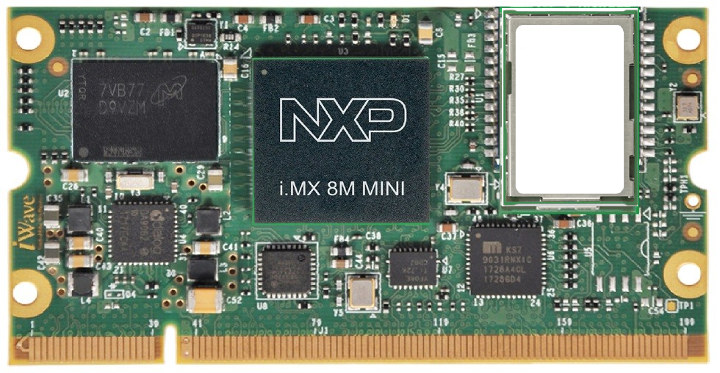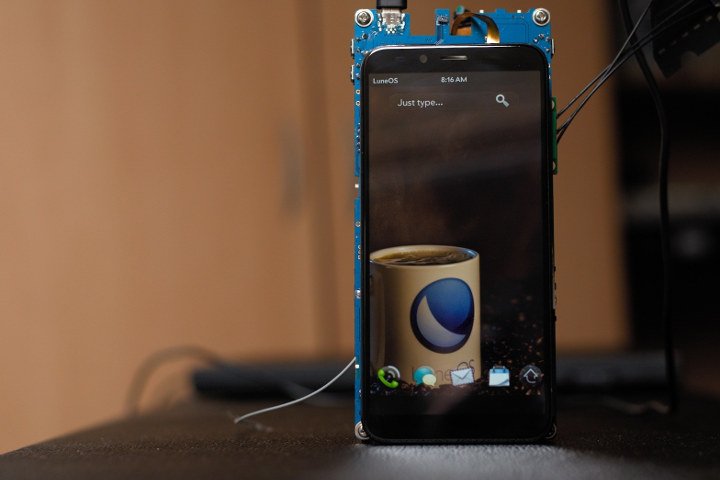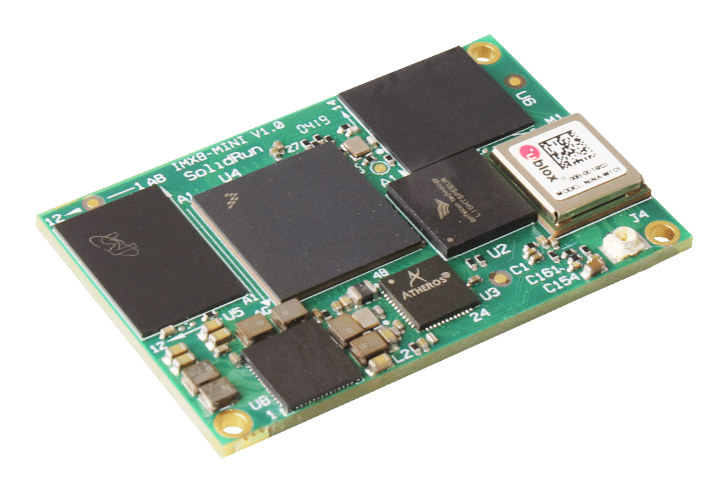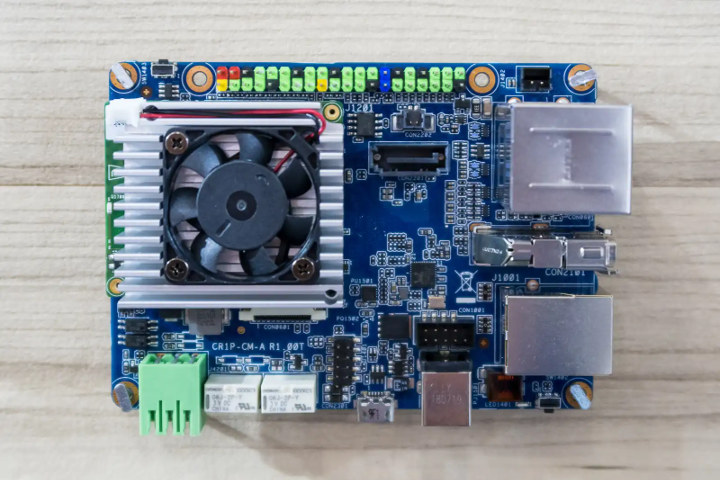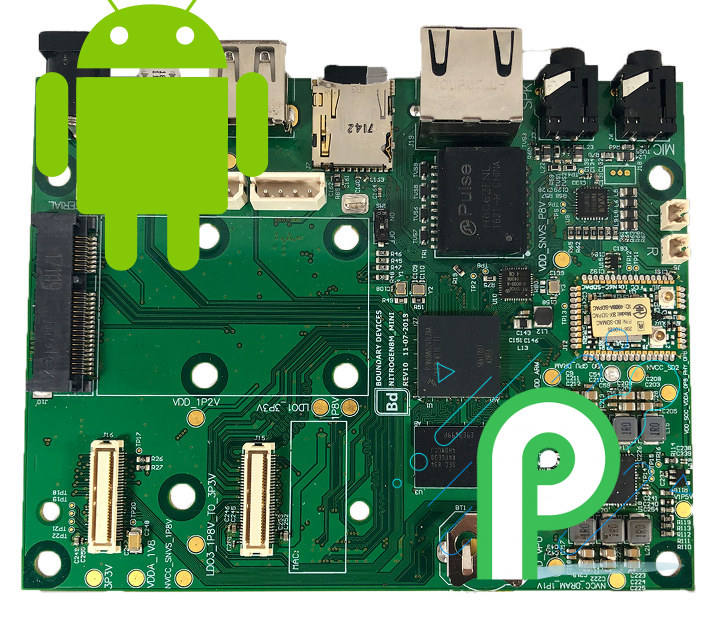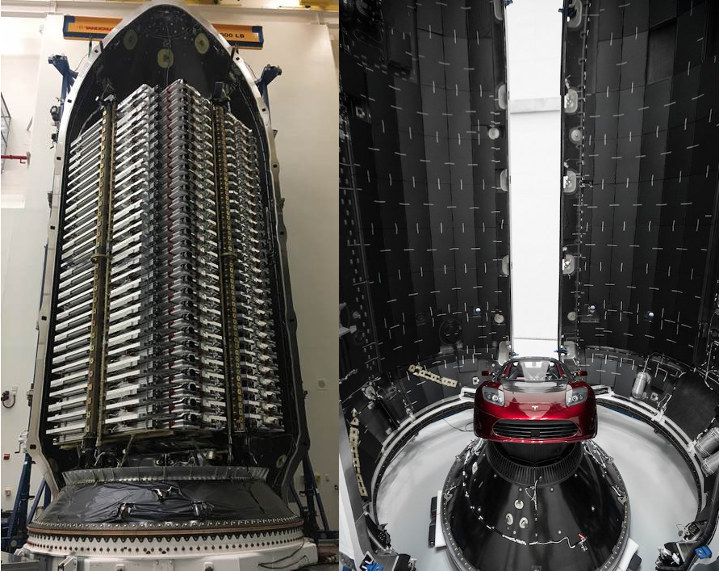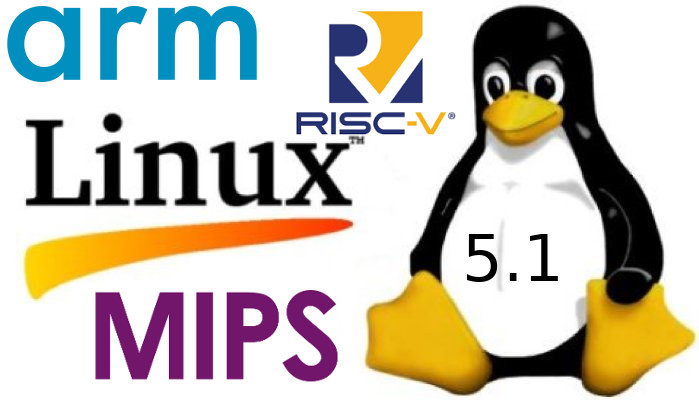MYiR Tech Limited (aka MYiR) has launched a new NXP i.MX 8 CPU module – MYC-JX8MX – powered by NXP i.MX 8M processor, as well as the corresponding MYD-JX8MX development kit. The module integrates up to 2GB LPDDR4 RAM, 8GB eMMC flash, 256Mbit QSPI Flash, Gigabit Ethernet PHY & PMIC onboard, and I/O signals are accessible from a 314-pin MXM 3.0 expansion connector. Typical applications for the company’s latest system-on-module include scanning/imaging solutions, building automation and smart home, human-machine interface (HMI), machine vision or other consumer and industrial applications requiring multimedia capabilities. MYC-JX8MX CPU Module Specifications: SoC – NXP i.MX 8M quad-core Arm Cortex-A53 processor @ 1.3GHz, Arm Cortex-M4 real-time core @ 266MHz, 2D and 3D GPU System Memory – 1GB or 2 GB LPDDR4 (supports up to 4GB LPDDR4) Storage – 8GB eMMC Flash (supports up to 64GB), 256Mbit QSPI Flash 314-pin MXM 3.0 edge connector with: 1x Gigabit […]
iWave Systems Unveils iW-RainboW-G34M-SM i.MX 8M Mini/Nano System-on-Module
NXP nomenclature for their i.MX 8M processors can be a little confusing. First discovered in 2016, the original i.MX 8M processor family comes with one to four Arm Cortex-A53 cores, a real-time Cortex M4 core, targets multimedia application with FullHD or 4K decoding/encoding support and is manufactured using a 28nm process. NXP then announced i.MX 8M Mini processor family in February 2018 with a 14-nm FinFET processor allowing a higher maximum CPU frequency of 2.0 GHz, less video output interfaces (no HDMI, nor DisplayPort), and optional Full HD video encoder and decoder, .e.g no 4K. Finally, earlier this year, the company unveiled NXP i.MX 8M Nano further power-optimized with the same 14nm manufacturing process, but a lower frequency of 1.5 GHz, and a Cortex-M7 core replacing the Cortex-M4 core found in previous i.MX 8M processors. This allows i.MX 8M Nano SoC to have a 2W TDP, and achieve sub-watt power […]
Software Development on Librem 5 and PinePhone Linux Phones is Progressing Nicely
Several Linux phones are expected this year including Purism Librem 5 and Pine64 PinePhone. Both companies have sent phone development kits out to developers a few months ago, and we are starting to see some nice progress for both phones. What made me write this post is an update from Purism comparing the boot time on Librem 5 running PureOS Linux distribution without specific optimizations yet, and HTC One Android smartphone. Librem 5 smartphone devkit takes 13 seconds to get to the lockscreen, while the Android phone takes over 40 seconds. Fair enough, most people won’t boot their phone often, but it still nice to know it won’t take long to turn on the phone from power off state. They also posted a progress report at the end of May saying calls are now working with better audio quality, fixed various issue with messaging in Chatty, work on Linux […]
SolidRun i.MX 8M Mini SoM Includes Gyrfalcon Lightspeeur 2803S AI Accelerator
There are already plenty of NXP i.MX 8M Mini boards and system-on-modules, but so far none of those included a neural network accelerator. But that’s now an option as SolidRun and Gyrfalcon teamed up to design SolidRun i.MX 8M Mini system-on-module that combines NXP i.MX 8M Mini processor with Gyrfalcon Lightspeeur 2803S NPU (Neural Processing Unit) in order to speed up AI workloads at the edge. SolidRun i.MX 8M Mini SoM Specifications: SoC (one or the other) NXP i.MX8M Mini S single core Arm Cortex-A53 processor up to 1.8 GHz, Arm Cortex-M4 core up to 400MHz, GC NanoUltra 3D GPU + GC320 2D GPU NXP i.MX8M Mini D dual-core Arm Cortex-A53 processor up to 1.8 GHz, Arm Cortex-M4 core up to 400MHz, GC NanoUltra 3D GPU + GC320 2D GPU NXP i.MX8M Mini Q quad-core Arm Cortex-A53 processor up to 1.8 GHz, Arm Cortex-M4 core up to 400MHz, GC NanoUltra […]
ASUS Tinker Edge T & CR1S-CM-A SBC to Feature Google Coral Edge TPU & NXP i.MX 8M Processor
A few months ago, Google introduced its Coral development board and USB accelerator powered by their Edge TPU delivering up to 4 TOPS and optimized for Tensorflow Lite. ASUS and Google have now partnered to bring more solutions powered by Coral Edge TPU namely ASUS Tinker Edge T board for makers and hobbyists, CR1S-CM-A SBC for industrial projects, and even a full computer fitted with a Google Edge TPU PCIe card. ASUS Tinker Edge T ASUS Tinker Edge T preliminary specifications: SoC – NXP i.MX 8M quad-core Arm Cortex-A53 processor with Arm Cortex-M4F real-time core, GC7000 Lite 3D GPU ML accelerator – Google Edge TPU co-processor System Memory – 1GB LPDDR4 RAM Storage – 8 GB eMMC flash Connectivity – Gigabit Ethernet port, Wi-Fi 2×2 MIMO (802.11b/g/n/ac 2.4/5GHz), and Bluetooth 4.1 Video Output – MIPI DSI connector, and HDMI output Camera I/F – 2x MIPI CSI 2 interfaces for stereoscopic […]
Boundary Devices NXP i.MX 8M Mini Board Gets Android 9.0 Firmware
Beside Debian 9.5, Ubuntu 18.04, the Yocto Project, and Buildroot Linux, NXP i.MX 8M Mini processors also supported Android 8.1 Oreo. But Boundary Devices has just announced their Nitrogen8M_Mini single board computers is now getting support for Android 9.0 Pie operating system. The company worked with Kynetics to release an Android 9.0 evaluation image for the i.MX8M Mini boards based on Linux 4.14.x kernel. You can also get the source code to build it from scratch for your board:
|
1 2 3 4 |
mkdir myandroid cd myandroid repo init -u git://github.com/boundarydevices/android-manifest.git -b boundary-imx-p9.0.0_1.0.0-ga repo sync |
You’ll also need NXP vendor package, which you can install as follows:
|
1 2 3 4 5 6 |
tar xvzf imx-p9.0.0_1.0.0-ga.tar.gz cp -r imx-p9.0.0_1.0.0-ga/vendor/nxp/ vendor/ cp -r imx-p9.0.0_1.0.0-ga/EULA.txt . cp -r imx-p9.0.0_1.0.0-ga/SCP* . rm -rf imx-p9.0.0_1.0.0-ga/ rm imx-p9.0.0_1.0.0-ga.tar.gz |
The last step is to build the code:
|
1 2 3 |
source build/envsetup.sh lunch nitrogen8mm-userdebug make 2>&1 | tee build.out |
You can find more details, including instructions to flash the image in the getting started guide. The image and source code are only suitable for evaluation, and you’d have to work yourself to get a production-ready version with security patches, field upgrade, and performance improvements, or ask Boundary […]
Xilinx Arm FPGA, Snapdragon SoM’s, and Wandboard SBC Field Trip to Space
Most embedded systems are used here on planet earth, but some do take off heading for space, and this week I come accross two separate projects leveraging Arm processors and FPGAs, as well as Ubuntu/ROS and Android operating systems: SpaceX Starlink communication satellites and Astrobee robots roaming in the international space station (ISS) SpaceX Starlink Satellites with Xilinx Ultrascale+ Arm + FPGA SoC SpaceX is about to launch a cloud of 60 Starlink communication satellites that aims to provide internet communication anywhere in the world. That’s just a start as eventually the plan is to get up to 12,000 of those satellites. Usually, we would not know many technical details about the satellites, but as one reader pointed out (Thanks Lawrence!), a Reddit thread about the launch, also pointed to a NASA document revealing the satellites are powered by Xilinx Ultrascale+ quad core Cortex-A53 processor with FPGA fabric. Milestone 2 […]
Linux 5.1 Release – Main Changes, Arm, MIPS & RISC-V Architectures
Linus Torvalds has just announced the release of Linux 5.1: So it’s a bit later in the day than I usually do this, just because I was waffling about the release. Partly because I got some small pull requests today, but mostly just because I wasn’t looking forward to the timing of this upcoming 5.2 merge window. But the last-minute pull requests really weren’t big enough to justify delaying things over, and hopefully the merge window timing won’t be all that painful either. I just happen to have the college graduation of my oldest happen right smack dab in the middle of the upcoming merge window, so I might be effectively offline for a few days there. If worst comes to worst, I’ll extend it to make it all work, but I don’t think it will be needed. Anyway, on to 5.1 itself. The past week has been pretty calm, […]



